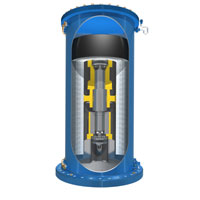
Energy storage is something we’ve come to take for granted in everyday life. Our cell phones, iPods, cars and computers all depend on batteries. But storing large amounts of energy for the electric grid is another matter entirely. It’s a technical challenge that has yet to be met–but will need to be for the coming age of renewable energy.
California’s grid is designed to deliver electricity on a real-time basis. Every four seconds, the grid operators at the California Independent System Operator (ISO) have to ensure that the energy supply meets the demand in the state, something that’s known as “balancing” the grid (you can see today’s electricity forecast on the ISO site). As a result, they coordinate the one piece of the system that they have control over: the power plants.
Traditional “baseload” generators like gas and nuclear plants produce a steady stream of electrons. But California is adding increasing amounts of solar and wind power to the grid each year. Since the output of a solar or wind farm depends on the sun or wind, the power they produce is intermittent (here’s a time-of-day profile of renewable energy on the grid today). That causes problems for the grid operators on a number of levels. Wind farms produce most of their power at night, but that’s when demand for power is lowest. Energy from solar farms using photovoltaics can drop off substantially when the sun disappears behind clouds. And large solar-thermal arrays ramp up extremely fast when first hit by the sun in the morning.
Energy storage is one of the ways that utilities and grid operators can address this intermittency. By having some extra electricity on hand, they can smooth out the bumps caused by these renewables. Here’s a review of some tried and new technologies for grid storage:
Batteries
There are a number of different kinds of batteries that can be used in grid-scale installations. I visited a two-megawatt battery in Huntington Beach that uses lithium-ion cells, much like a hybrid car or newer power tools. Southern California Edison is working on an 8 MW battery project near the Tehachapi wind farms. But lithium-ion technology has plenty of competitors, many of which have been awarded federal stimulus funding. The primary barrier for batteries is the cost.

Flywheels
This technology uses rotational energy to store power. Flywheels have an internal rotor that uses electricity to spin at high speeds. When energy is needed, the rotor slows down and generates electricity through a motor. This is used for what’s known as “frequency regulation” on the grid. Since they can charge and discharge power on a second-to-second basis, flywheels smooth out the short-term fluctuations on the grid. Beacon Power has installed flywheels in Tehachapi, California as part of a demonstration project there.
Compressed Air
Using energy produced at non-peak times (at night), compressed air storage projects pump air into large underground caverns. When demand for energy is high, it’s released to run power turbines. PG&E is now planning a 300 MW compressed air facility in Kern County.
Of course, for all these technologies, cost is a major issue, not to mention the siting and planning considerations. To see how they stack up, check out these technology comparison charts from the Energy Storage Association.
Pumped Hydro
In the energy storage world, this is as old-school as it gets. Hydro-power uses water and gravity to generate electricity. Storage is added by pumping that water back uphill to the reservoir, so it can generate power again. Of course, it takes electricity to run the pumps, so the uphill run generally happens at night, when there is cheaper or excess power on the grid. California’s largest pumped hydro facility is PG&E’s Helms Pumped Storage Project outside of Fresno, which has a 1.2-gigawatt capacity (more about that in this Powerpoint presentation). PG&E is reportedly considering two gigawatts of new pumped storage at two other sites in California.
For more, listen to my radio story online and check out the rest of our stories in our ongoing series: 33 x 20: California’s Clean Power Countdown.
One thought on “Energy Storage: The Holy Grail”
Comments are closed.

it is apperant that linear acelerators designed inductivly can produce large amounts of power with a spit tee inversion kit and a tank of meth hydrate crystal and oil at 2.5 vac,and a byproduct of hyd,2 makes alot of sense for future technolgy and should be investagated,its time to move away from nuckes that are affecting our atmosphere and our health.